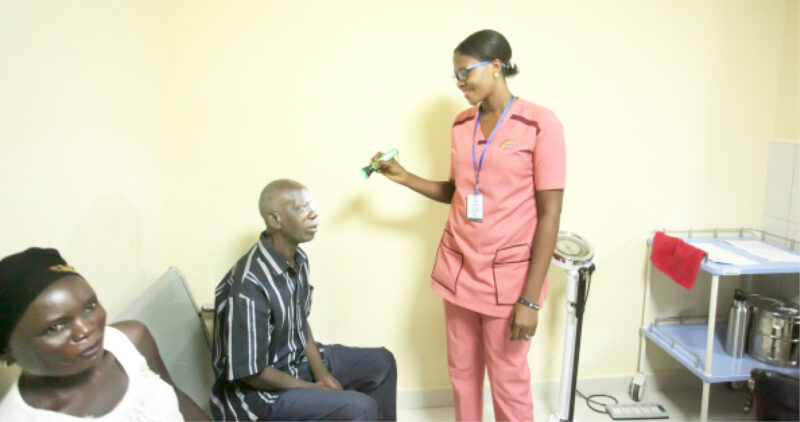Cataracts are a leading cause of blindness globally, making up a huge percentage of the blind and visually impaired, according to the World Health Organisation. While it can affect people of all ages, its prevalence increases dramatically with age, ranging from as low as 3.9% in the 55-64 age group to 92.6% in those 80 and older. Although cataracts are a global issue, developing countries, particularly in sub-Saharan Africa, face an excessively higher burden of cataract-related blindness.
In Nigeria, they are the primary cause of blindness and visual impairment, according to the Nigerian National Blindness and Visual Impairment Survey, which found that cataracts account for 43% of blindness and 45.3% of severe visual impairment. A more recent study indicated a 19.8% prevalence of cataracts in adults aged 40 and above, and it is higher in women, those with lower socioeconomic status, and those in rural areas.
Now, a cataract is a clouding of the eye’s natural lens, which is located behind the iris and pupil, and the lens is responsible for focusing light onto the retina, which then sends signals to the brain, allowing people to see. The lens is clear in a healthy eye. However, in an eye with a cataract, the proteins in the lens break down and clump together, scattering and blocking light from reaching the retina. This can cause hazy, blurry, or double vision, make colours seem faded, and increase sensitivity to light.
SPONSOR AD
Cataracts are primarily categorised by their location of formation and cause. Age-related cataracts are the most common. Cataracts can also be congenital (present at birth), secondary (caused by other conditions or medications), traumatic (from eye injury), or radiation-induced (from radiation exposure).
The truth is that many factors contribute to developing cataracts. As people get older, the lens proteins can break down and clump together, leading to clouding. A family history of cataracts can equally increase your risk, suggesting a genetic component to their development. Also, traumatic injuries to the eye can damage the lens and increase the risk of cataract development, especially in younger adults.
In addition, people with diabetes are at higher risk for cataracts. Conditions like glaucoma or uveitis can similarly contribute to cataract development. Certain systemic diseases like neurofibromatosis type 2, myotonic dystrophy, and atopic dermatitis can likewise be associated with cataracts. Also, long-term use of steroid medications, especially corticosteroids, can increase the risk of developing cataracts.
Furthermore, smoking is a risk factor for various health issues, including cataracts. Heavy alcohol use is also associated with an increased risk of cataracts. Prolonged exposure to ultraviolet (UV) radiation from the sun can damage the lens and equally contribute to cataract formation. Secondary cataracts often develop as a result of other eye conditions or surgeries, such as those involving the retina or vitreous humour.
Now, cloudy, blurry, or foggy vision is often the first noticeable symptom, as the cataract makes it harder for light to pass through the lens. There is difficulty seeing at night because the cataract scatters light, making it harder to see in low-light conditions. There is also increased sensitivity to light and glare, as bright lights, like headlights or sunlight, can be uncomfortable and cause squinting or difficulty seeing.
In addition, there can be halos around lights, as light can be distorted by the cataract, creating a ring of light around bright objects. Cataracts can also affect how colours are perceived, making them appear less vibrant or with a yellowish tint. Double vision (in one eye) can occur when the cataract disrupts the way light is focused on the retina. As the cataract progresses, vision will change, requiring more frequent adjustments to corrective lenses. Besides, there can be difficulty reading or doing other close-up tasks, as one may need more light or find it challenging to focus on fine details. Noteworthy is the fact that cataracts develop gradually, so one may not notice any symptoms at first.
Although there is no foolproof way of preventing cataracts entirely, several lifestyle choices and preventative measures can hugely reduce the risk and slow their progression. These include maintaining a healthy diet, avoiding smoking, managing other health conditions, and protecting your eyes from the sun. Regular eye examinations are also vital for early detection and management.
So, you need to be deliberate about a diet rich in vegetables, leafy greens, and colourful fruits. These are packed with antioxidants like zeaxanthin and lutein, as well as vitamins A, C, and E, which are beneficial for eye health. Instead of refined grains, eat whole grains, as they provide essential nutrients for eye health, and include foods rich in omega-3s, such as flaxseed oil, fish (tuna, salmon, etc.), and walnuts, or consider supplements.
In addition, avoid smoking, as smoking is a significant risk factor for cataracts, and quitting can reduce your risk and improve your overall health. You can consider seeking help from healthcare providers or support groups if you are struggling to quit.
It is also important to control blood sugar levels, as this is crucial for preventing cataracts, especially for individuals with diabetes, and manage your high blood pressure if you are hypertensive. Then protect your eyes from the sun by wearing sunglasses that block 100% of UVA and UVB rays. You may also consider wearing a hat with a brim to further shield your eyes. Equally crucial is scheduling regular eye exams with an eye doctor, especially after the age of 40, as early detection allows for timely intervention and management of cataracts and other eye conditions.
The only effective treatment for cataracts is surgery. So, if cataracts are causing vision problems that interfere with your daily activities, surgery can be carried out to remove the clouded lens and replace it with an artificial lens. In its early stage, stronger lighting and new glasses or contacts can help, but these are just temporary solutions, as cataracts worsen over time.
Cataracts are a common vision-impairing condition, particularly among older adults. You can considerably reduce your risk of developing them, and maintain healthy vision for as long as possible, by adopting preventative measures. However, if you are already experiencing vision changes, it is time to schedule an eye examination with an optometrist or ophthalmologist. Whatever the outcome, rest assured that help is available. But you need to seek it early to avoid the tragedy of complete vision loss.
Ojenagbon, a health communication expert and certified management trainer and consultant, lives in Lagos.








